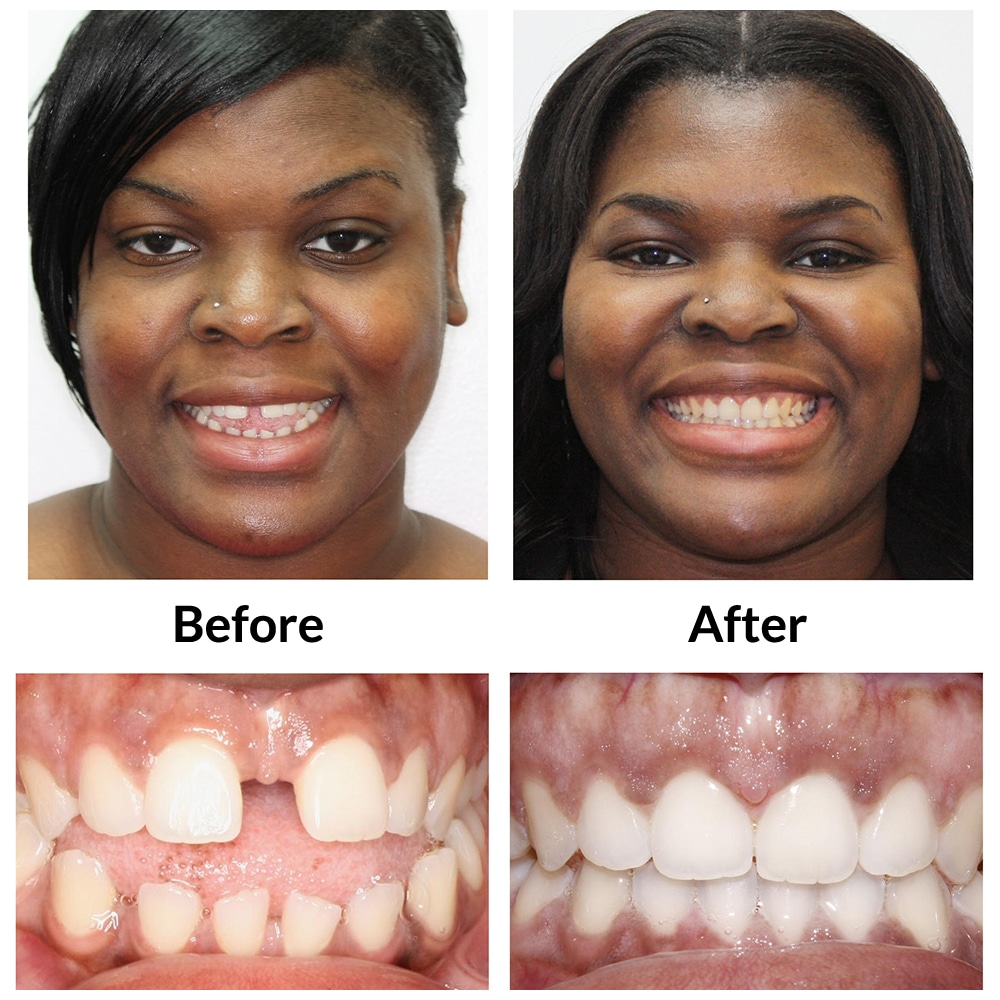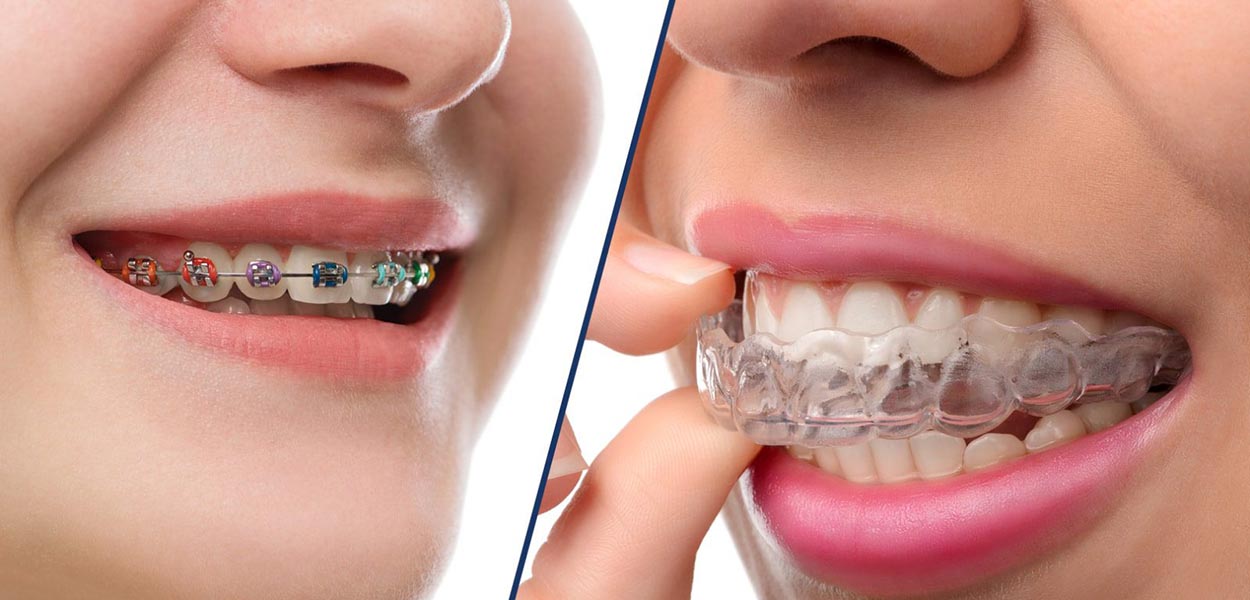Invisalign vs. Typical Braces: Which Choice Is Right for You?
When taking into consideration orthodontic therapy, the selection between Invisalign and conventional dental braces offers a number of crucial factors that warrant mindful examination. Invisalign offers a discreet alternative with detachable aligners, while traditional dental braces supply a more noticeable yet efficient solution for serious imbalance. Each option includes distinct advantages and disadvantages connected to looks, convenience, therapy duration, and expense. Comprehending these subtleties is critical for making an educated choice that straightens with your personal choices and way of living. The inquiry remains: which option will ideal fulfill your orthodontic requirements and expectations?
Introduction of Treatment Alternatives

In comparison, conventional dental braces consist of steel braces and cables that are adhered to the teeth. This approach uses continual pressure in time to achieve placement. While reliable for intricate orthodontic problems, standard dental braces require routine brows through for changes and can pose challenges in maintaining oral health because of the difficulty of cleaning up about cords and braces.
Both choices have their advantages, and the choice commonly rests on certain dental problems, way of living preferences, and individual compliance. Inevitably, consulting an orthodontic specialist is crucial for figuring out the most ideal treatment strategy tailored to individual needs. Understanding the subtleties of each alternative can substantially influence the total success of orthodontic therapy.
Visual Factors To Consider
A considerable factor affecting the selection between Invisalign and traditional dental braces is the aesthetic allure each therapy uses. Invisalign aligners are crafted from clear plastic, making them basically invisible when used.
On the other hand, standard dental braces consist of metal braces and cords, which can be more noticeable. While advancements in orthodontic innovation have brought about the advancement of smaller brackets and tinted elastics, standard braces still keep an even more conspicuous profile. For some people, the exposure of dental braces might hinder them from looking for needed therapy.
Inevitably, the option between Invisalign and conventional dental braces may depend upon personal choices pertaining to visual appeals. Clients who focus on discretion usually lean toward Invisalign, while those who are less worried about visibility might opt for standard braces. Understanding the visual ramifications of each option is important for making an educated decision that lines up with one's lifestyle and preferences.
Convenience and Convenience

In terms of convenience, Invisalign aligners are removable, making it possible for patients to appreciate their favored foods without constraint and keep optimum dental hygiene. Cleaning and flossing are simplified, as the aligners can be taken out during these regimens, whereas standard braces need mindful steering around cables and braces.
In comparison, typical braces require find out this here regular adjustments, making them less hassle-free for those with hectic routines. On the whole, the convenience and comfort of Invisalign make it an enticing choice for several individuals looking for orthodontic therapy.
Therapy Period and Performance
While both Invisalign and typical dental braces work in dealing with oral misalignments, the duration of therapy can differ substantially in between both choices. Generally, Invisalign therapy can take anywhere from 12 to 18 months, relying on the complexity of the situation. The clear aligners work by progressively moving teeth right into their desired positions, and routine follow-ups with an orthodontist help make sure development continues to be on track.
In contrast, traditional dental braces often need a longer dedication, typically ranging from 18 months to three years. This is due to their set nature and making use of cords and braces, which can be extra efficient for intricate situations and severe misalignments (Invisalign). The therapy effectiveness of typical dental braces is well-documented, as they permit specific changes and greater control over tooth activity
Inevitably, the selection in between Invisalign and conventional dental braces may depend upon both the expected treatment duration and the details dental issues at hand. Consulting with an orthodontist is critical, as they can offer tailored suggestions based upon individual needs, making certain the chosen technique straightens with wanted durations and results.
Expense Contrast and Insurance Alternatives
Cost plays a considerable function in the decision-making procedure for individuals taking into consideration orthodontic treatment, whether going with Invisalign or standard dental braces. On average, the expense of Invisalign arrays from $3,000 to $8,000, while traditional dental braces commonly set you back between $2,000 and $6,000. navigate here Factors influencing these prices include the intricacy of the instance, the period of therapy, and geographical place.
Many dental insurance coverage strategies give partial coverage for orthodontic treatments, but the specifics can vary commonly. Generally, traditional braces might be a lot more regularly covered by insurance coverage strategies contrasted to Invisalign, which some insurers categorize as a cosmetic treatment.
Additionally, several orthodontic practices offer versatile layaway plan, making both therapy alternatives a lot more available. Patients should ask about prospective financing alternatives and price cuts for upfront payments. Reviewing the total price, including insurance advantages and payment plans, is essential for making an informed choice that straightens with both visual choices and spending plan factors to consider.

Verdict
In summary, the selection in between Invisalign and conventional dental braces depends upon multiple variables, consisting of visual choices, convenience, treatment period, and expense. Invisalign uses a very discreet, detachable option that helps with oral hygiene and dietary versatility, while typical braces Clicking Here may be a lot more appropriate for complex dental concerns and usually come at a lower rate point. Eventually, appointment with an orthodontist is vital to examine specific conditions and establish one of the most ideal therapy alternative for accomplishing optimal oral alignment.
When taking into consideration orthodontic treatment, the selection in between Invisalign and typical dental braces presents a number of important variables that warrant mindful analysis.Comparing Invisalign and standard dental braces exposes unique therapy options for orthodontic adjustment.While both Invisalign and typical dental braces are effective in correcting oral imbalances, the period of therapy can vary considerably in between the 2 options.Price plays a substantial role in the decision-making process for people considering orthodontic treatment, whether deciding for Invisalign or traditional braces.In summary, the option between Invisalign and traditional dental braces pivots on several elements, consisting of visual preferences, convenience, treatment period, and expense.
Comments on “Discover the Conveniences of Invisalign for a Perfect Smile Transformation”